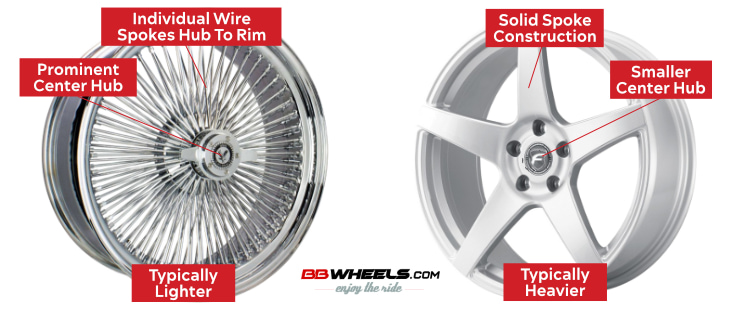Wire Wheels vs Regular Wheels: Which is Right for Your Vehicle?

Introduction
Wire wheels are a type of wheel that has been used on cars for many years and are often associated with classic and vintage vehicles. They are constructed from a central hub, a series of wire spokes radiating outwards, and a rim that holds the tire in place.
Wire wheels have a number of advantages over other types of wheels. One of the primary advantages is their distinctive appearance. The wire spokes provide an open and intricate design that is visually appealing and adds a touch of elegance to the vehicle. This is one of the reasons why wire wheels are often used on classic or vintage cars, as they enhance the overall aesthetic of the vehicle and add to its charm.
Another advantage of wire wheels is their lightweight construction. Compared to regular wheels, wire wheels are typically lighter, which can improve the vehicle's handling and acceleration. This is because lighter wheels require less energy to spin, which can lead to improved performance and fuel efficiency.
Wire wheels also offer some degree of flexibility and shock absorption, which can improve the vehicle's ride quality. The wire spokes can flex slightly when the vehicle encounters bumps or rough road surfaces, which helps to absorb some of the impact and reduce vibrations. This can result in a smoother and more comfortable ride for the driver and passengers.
However, there are also some disadvantages to wire wheels. One of the main drawbacks is that they require more maintenance than regular wheels. The wire spokes can become dirty or corroded over time, and it can be difficult to clean them thoroughly. Another potential issue with wire wheels is that they can be more expensive than regular wheels. This is partly due to their more complex construction, as well as the fact that they are less common than regular wheels. Additionally, some wire wheels are made from more expensive materials, such as chrome or polished stainless steel, which can further increase the cost.
Historical Background
Wire wheels have a long history in the automotive industry, dating back to the late 1800s when they were first used on bicycles. They were later adapted for use on cars and became popular in the early 1900s. One of the earliest and most famous examples of wire wheels on a car was the 1901 Mercedes 35 hp, which used wire-spoke wheels that were made from hardened steel.
Over the years, wire wheels have remained a popular choice for car enthusiasts, and have been used on a wide range of vehicles, from classic sports cars to luxury sedans. Many automakers, including Jaguar, Rolls-Royce, and Bentley, have used wire wheels on their vehicles, and there are even aftermarket companies that specialize in producing wire wheels for a variety of different makes and models.
Types of Wire Wheels
There are a number of different types of wire wheels available, each with its own unique design and features. One common type is the knock-off wire wheel, which features a central spinner that can be removed to access the lug nuts for tire changes. Another type is the bolt-on wire wheel, which is similar to a regular wheel but with wire spokes instead of solid metal spokes.
In addition to these basic types, there are also a variety of different sizes and styles available. Some wire wheels are designed to fit specific models or types of cars, while others are more universal and can be used on a variety of different vehicles. Additionally, there are wire wheels available in a range of colors and finishes, including chrome, polished stainless steel, and painted options.
Maintenance of Wire Wheels
When selecting wire wheels, it is important to consider factors such as size, style, and compatibility with your vehicle. It is also important to consider the maintenance requirements of wire wheels, as they can require more upkeep than other types of wheels. Regular cleaning and inspection can help to ensure that your wire wheels remain in good condition and provide optimal performance and safety.
To properly maintain wire wheels, it is important to keep them clean and free of debris. The wire spokes can be difficult to clean, so it is recommended to use a soft-bristled brush and a mild soap solution to clean them thoroughly. It is also important to inspect the spokes for any signs of damage or corrosion, as this can weaken the structure of the wheel and compromise its safety.
Conclusion
Wire wheels are a unique and stylish choice for car enthusiasts, particularly those who appreciate classic or vintage vehicles. While they do have some disadvantages, such as increased maintenance requirements and higher costs, the benefits of wire wheels in terms of appearance, performance, and comfort make them a popular choice for many car enthusiasts. If you are looking for a way to enhance the appearance and performance of your car, wire wheels are definitely worth considering.
Overall, wire wheels offer a unique combination of style, performance, and comfort that is difficult to replicate with other types of wheels. They have a long and interesting history in the automotive industry, and are still a popular choice for car enthusiasts today. With the right maintenance and care, wire wheels can provide many years of reliable and enjoyable use on your vehicle.
